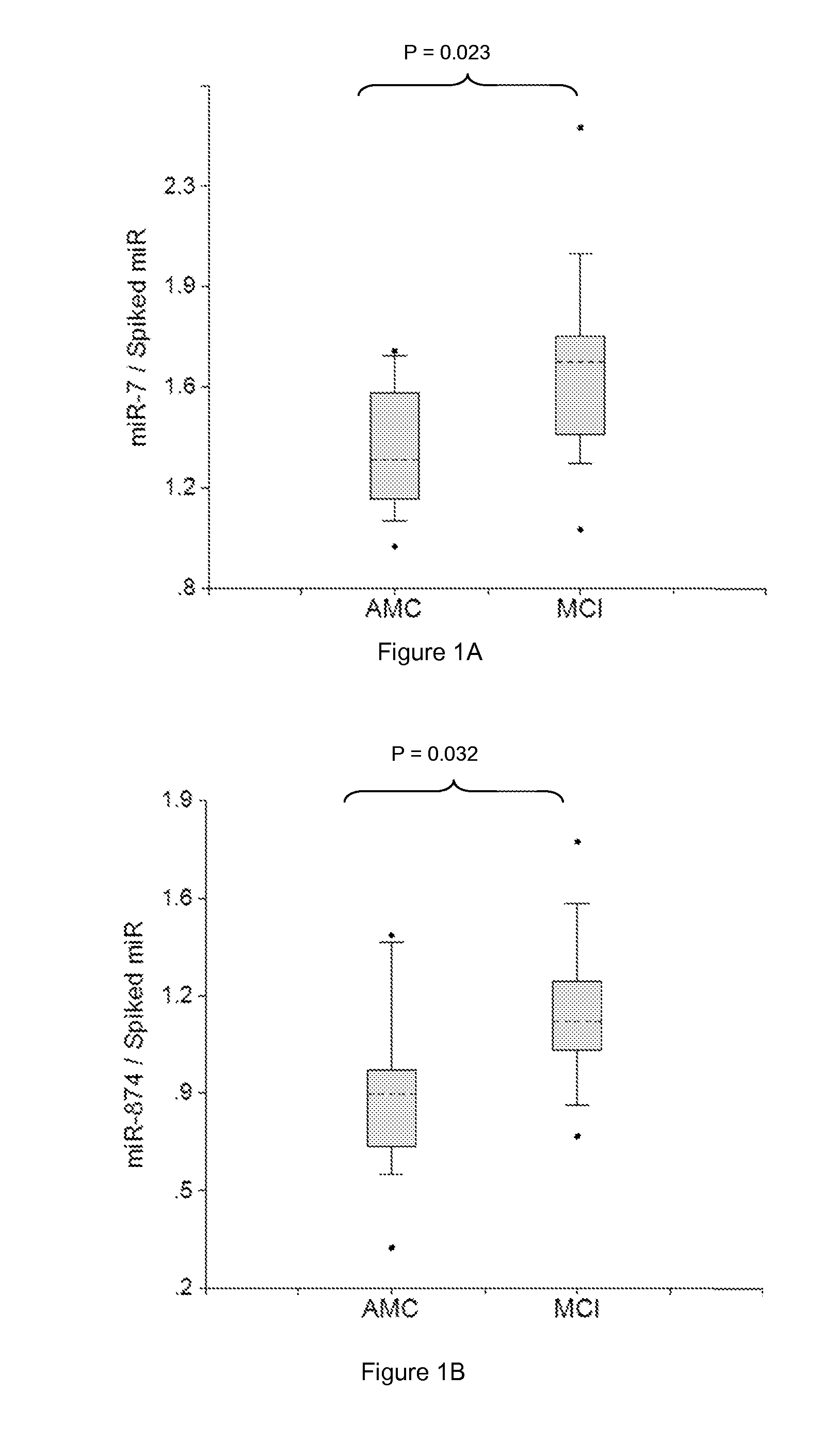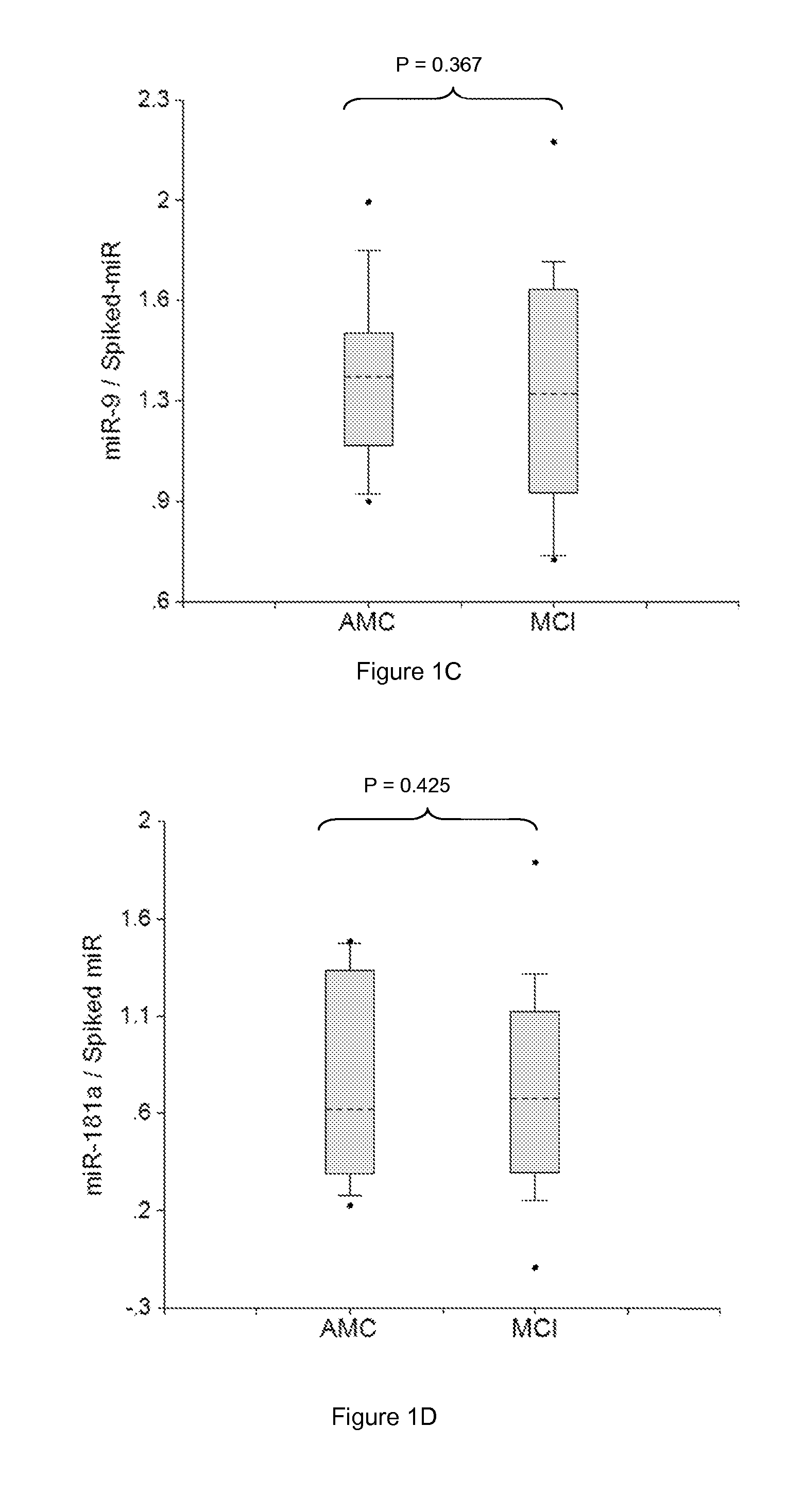METHODS OF USING miRNA FROM BODILY FLUIDS FOR EARLY DETECTION AND MONITORING OF MILD COGNITIVE IMPAIRMENT (MCI) AND ALZHEIMER'S DISEASE (AD)
a technology of mirna and bodily fluids, applied in the field of using mirna from bodily fluids for early detection and monitoring of mild cognitive impairment (mci) and alzheimer's disease (ad), can solve the problems of late clinical manifestation of disease symptoms, complicated drug development and successful treatment of ad and other neurodegenerative diseases, and increase the cost of clinical trials. , to achieve the effect of improving the effectiveness of currently available treatments, reducing costs, and improving clinical trials
- Summary
- Abstract
- Description
- Claims
- Application Information
AI Technical Summary
Benefits of technology
Problems solved by technology
Method used
Image
Examples
example 1
Comparison of Different Methods Used for miRNA Purification from Serum or Plasma
[0268]There are many commercial kits for miRNA isolation, including the miRNeasy kit (Qiagen), the MirVana RNA isolation kit (Ambion / ABI), miRACLE (Agilent), High Pure miRNA isolation kit (Roche), and miRNA Purification kit (Norgen Biotek Corp.). Besides, the in-house techniques based on the use of Trizol (Invitrogen) can be used. In this technique (Invitrogen's protocol), after Trizol LS deproteinization, RNA is precipitated with isopropyl alcohol or additionally purified on silica columns. In some experiments, purified RNA is treated with RNAse-free DNAse (Qiagen, ABI, Invitrogen or other).
[0269]miRNA preparations obtained by different methods were compared using RT-PCR. Using Trizol LS (Invitrogen's protocol) and the MirVana RNA isolation kit (Ambion / ABI protocol) miRNA was purified from plasma and serum samples obtained from the same 5 healthy donors. 107 copies of Arabidopsis thaliana miR-159a (ath-...
example 2
Selection of miRNA for Testing
[0271]Tested miRNAs were initially selected based on literature data on their enrichment in brain compartments and presence in neurites (i.e., axons and / or dendrites and / or spines) and / or synapses (Hua et al., BMC Genomics 2009, 10:214; Liang et al., BMC Genomics. 2007, 8:166; Landgraf et al., Cell. 2007, 129:1401-1414; Lee et al., RNA. 2008, 14:35-42; Schratt et al., Nature. 439:283-289, 2006; Lugli et al., J. Neurochem. 106:650-661, 2008; Bicker and Schratt, J Cell Mol Med., 12:1466-1476, 2008; Smalheiser and Lugli, Neuromolecular Med. 11:133-140, 2009; Rajasethupathy, Neuron. 63:714-716, 2009; Kye, RNA 13:1224-1234, 2007; Yu et al., Exp Cell Res. 314:2618-2633, 2008; Cougot, et al., J. Neurosci. 28:13793-13804, 2008; Kawahara, Brain Nerve. 60:1437-1444, 2008; Schratt G. Rev Neurosci. 2009; 10:842-849; Pichardo-Casas et al. Brain Research. 1436:20-33, 2012) as well as on their suggested involvement in neurite- and synapse-associated processes (The miR...
example 3
Experimental Pre-Selection of miRNA Biomarkers and Normalizers
[0272]Plasma samples were obtained from patients diagnosed with MCI with amnestic symptoms (aMCI) (Dlugaj et al., Dement Geriatr Cogn Disord., 2010, 30:362-373; Brooks, Loewenstein, Alzheimer's Res Therapy, 2010, 2:28-36). Profiles of brain-enriched miRNAs from plasma of these patients were analyzed using RT-PCR with primers and probes for each individual miRNA (ABI). The amount of RNA equivalent to 30 μL plasma were taken in each RT reaction, and 1 / 15 of RT product was taken into final PCR. Thus, the amount of miRNA equivalent to 2 μL plasma was detected. The results obtained for each miRNA were normalized per each potential normalizer miRNA, converted into Relative Concentration (RC) of miRNA according to the ABI protocol (2−Ct), and compared with miRNA profiles from age-matched controls (AMC). Practically, all miRNA analyzed were tested as potential biomarkers and normalizers and combinations, which provided statistica...
PUM
| Property | Measurement | Unit |
|---|---|---|
| distance | aaaaa | aaaaa |
| distance | aaaaa | aaaaa |
| time | aaaaa | aaaaa |
Abstract
Description
Claims
Application Information
 Login to View More
Login to View More - R&D
- Intellectual Property
- Life Sciences
- Materials
- Tech Scout
- Unparalleled Data Quality
- Higher Quality Content
- 60% Fewer Hallucinations
Browse by: Latest US Patents, China's latest patents, Technical Efficacy Thesaurus, Application Domain, Technology Topic, Popular Technical Reports.
© 2025 PatSnap. All rights reserved.Legal|Privacy policy|Modern Slavery Act Transparency Statement|Sitemap|About US| Contact US: help@patsnap.com



